Can you really tow with a Battery Electric Vehicle (BEV)?
The answer from the vox populi would probably be no, based on years of electrified vehicles on the market that offer little or no (or at least, unrated) towing ability. The complex powertrains and bespoke transmissions of early hybrids did not lend themselves to towing – although it’s fair to say it was also probably not a priority for manufacturers at that time.

As electric power comes more into the mainstream and there’s more of a focus on BEVs, vehicle makers are now endowing their eco-friendly vehicles with the ability to tow trailers, caravans and boats into the great green-and-blue outdoors.
That should not surprise. In theory, BEVs are actually quite well suited to towing. Electric motors produce immense torque from startup and the single-speed transmissions employed by most pure-electric vehicles make for smooth progress when there’s a load to haul. Many high-end BEV SUVs are all-wheel drive as well, which means no problem with traction when towing over low-traction surfaces or up slippery boat ramps.
Premium makers have been leading the way – especially those with lifestyle-oriented BEV-SUVs in their ranks. BMW’s new iX SUV, which goes on sale in New Zealand later this year, has upped the ante considerable with a 2.5-tonne towing capacity.
That beats the previous champion, the Tesla Model X, with an also-impressive 2250kg. Audi’s e-tron also pulls its weight in this sector with a rating of 1.8 tonnes.
No, none of the above can match a traditional one-tonne ute for sheer haul-ability. But neither can most Internal Combustion Engine (ICE) crossover SUVs. The point is, fears that a shift toward BEVs will “end the weekend” are misplaced.

There is an elephant in the room, of course: range. In theory, the extra battery power consumed to tow a heavy load is no different to the extra fuel consumed by an ICE vehicle (which can be considerable). The difference comes in the range anxiety that is still prevalent with BEVs: higher power consumption during towing means more frequent recharging, which means more planning required around plug-in stops. Especially when BEVs don’t go as far as ICE vehicles before they need to be topped up.
That will require a bit more forethought when planning longer trips. But if the charging infrastructure is in place – and it is in New Zealand, with DC fast-charging stations every 75km on all but a couple of stretches of public highway, right through the country – all that’s needed is a slight change in mindset. Just the same as making the switch from ICE to BEV for any other type of driving.

How much range will you lose when towing with a BEV? That depends on many different variables, including the weight of your load and the terrain you’re tackling. But if you’re really taking advantage of your vehicle’s capacity and dealing with the open road and hills, you might loose half your range. On a model like the BMW iX, that might mean 250km between charges; but that’s still quite practical for recreational travel.
The extra power required for any vehicle (petrol, diesel or electric) to tow a load means extra cost for the owner. But the huge running-cost savings to be made in driving a BEV could really work in your favour here.







